Diners arriving at the The Tasty Toast might not notice a small sign above their heads: CLARENCE G. HEXTER BUILDING 1937. What is the story behind the sign? Hexter is not hard to identify. His headstone, inscribed 1882–1936, can be seen online. Finding out what he did between those two dates led me back to the world of Jay Emanuel, a notable entrepreneur in the movie theater industry, who had turned up during the jump from the fictitious New Yorker imitation in Kitty Foyle to the nonfictional Philadelphia imitation, Town Crier. Both magazines quickly folded, but the talented staff of Town Crier, including Emanuel, went on to success elsewhere.
Kitty Foyle and Philadelphia, the “grand homey old town”
The TOWN CRIER and the Talkies: Jay Emanuel and Other Reel Fellows
The lively, close-knit community of theater owners, bookers, and suppliers, like the punchy, vivid advertising that brought crowds to the movie palaces once found in every town and neighborhood, comes to life in the 1934–36 issues of Emanuel’s trade magazine, The Philadelphia Exhibitor, available from the virtual exhibitors of the Internet Archive. In them Hexter appears as an industry veteran, a wit, and a stalwart of the Independent Exhibitors Protective Association. He must have been a familiar figure on Vine Street between North Twelfth and North Juniper, the spine of Film Row.

Film Row, a single-industry district like Jewelers’ Row or South Fourth Street, was not new in the 1930s; the Sanborn fire insurance maps for that stretch of Vine show four “Film Exchange” sites on the south side (2: 110, 111) in 1916, as well as three theater-related businesses; and eleven “Film Exchange” sites, as well as one theater-related business, on the north side (4: 312, 313) in 1917. Hexter was in the business by then, as a partner in Consolidated Booking Offices in 1910, in the Odd Fellows Temple (known by 1913 as the Parkway Building) at North Broad and Cherry SE (the red-ringed

symbol on the map). This page focuses on 1934-36 to take advantage of the multitude of local advertisements published in Philadelphia Exhibitor. Of about a hundred Philadelphia businesses advertised during those years, more than half were in the area covered by the map above. (The linked symbols represent addresses where more than one business was present. One such address was on Race; the others were on Vine.) More than a dozen businesses were just outside the map, within four blocks, and the Film Folks (perhaps successors of Emanuel’s Reel Fellows) held celebrations nearby at the Broadwood Hotel (North Broad and Wood SW) and the Lulu Temple (Spring Garden east of North Broad).
From the north side of Vine Street, 1934–36:
From the vanished south side, 1934–36 (the symbol in the middle of Vine stands for a location given only as an intersection):
From the nearby blocks on the map, arranged south to north on east-west streets, and then east to west and south to north on north-south streets, 1934–36:

Film Row had passed its thriving time by the mid-1940s, though the 1942 land use map shows three “FILM DIST.” sites on blocks that have dwindled into parking lots. The end was predicted in 1941, with news of what was to become the Vine Street Expressway.
Today there are buildings at fewer than ten of the sites tagged on the map. One survivor is the elegant former flower shop featured in this Hidden City Philadelphia article by Grojlart:
https://hiddencityphila.org/2015/07/the-tastiest-morsel-of-season-city/
As that article suggests, Film Row, once bustling if not glamorous, is now bleak or nondescript, perhaps the last section of Center City that would come to mind, while the Clarence G. Hexter Building survives and apparently thrives. But it is at 1320 Point Breeze Avenue, more than twenty blocks from Film Row.
The explanation involves four theaters, three of which were operated by Hexter (and his brother Jack, who was involved with the theaters before and after the death of Clarence, when their brother Bill was also in town to help) on this lively local shopping street. Here is the former Dixie Theater (1912–53; dates from Irvin R. Glazer, Philadelphia Theaters) at 1224 Point Breeze.

Another was the Pastime (1911–53), 1420 Point Breeze, which is seen in a 1918 volume of the Sanborn fire insurance map (6: 548) to have been much larger (large enough to accommodate 800 people, according to Glazer) than the current building at the address.

The Breeze or Point Breeze (1911–53), 1638 Point Breeze, which was being operated by Jack Hexter in 1939, is now an empty lot.
There had been a theater on the site of the Hexter Building itself, the Premier (1912–31). Perhaps Hexter operated that theater as well. Perhaps the buildings are one and the same; the footprint of the theater in the 1918 Sanborn fire insurance map (6: 548) resembles that of the Hexter Building in the 1942 land use map. Of what went on there between 1937 and The Tasty Toast I can mention only this 1961 PhillyHistory photograph that shows it as the Potamkin five and dime.
https://www.phillyhistory.org/PhotoArchive/Detail.aspx?assetId=142926
Two surviving buildings (and good deeds)–not a bad legacy for a veteran of Film Row.




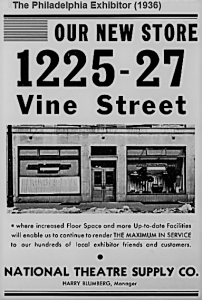


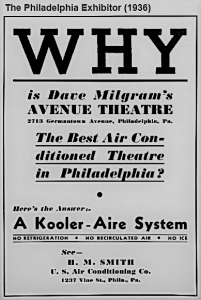






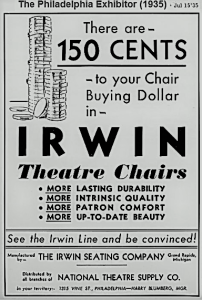





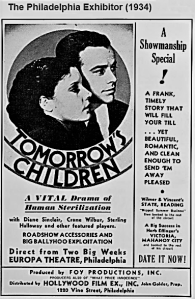


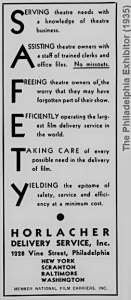






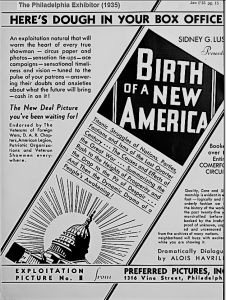
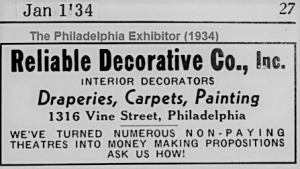
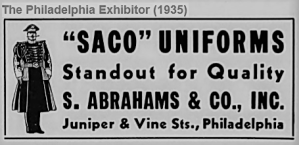



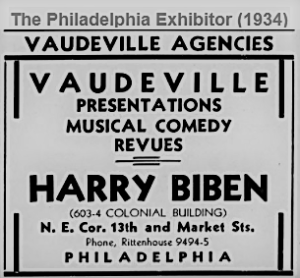

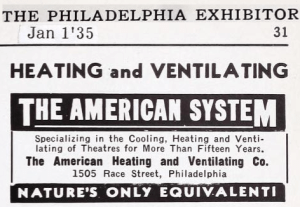



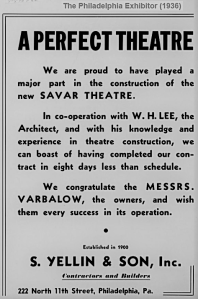





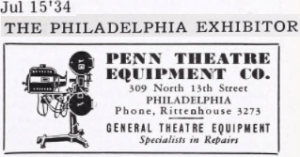



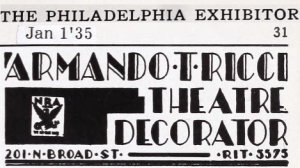


Of course the film industry originated back east before it moved out west to Hollywood starting in the early teens. A lot of the early movie moguls owned theaters in the east before the Hollywood studios even existed. So I’m not surprised to learn there was a Film Row in Philadelphia. If all these buildings had survived it would have made an interesting historical tour. Unfortunately a lot of the theaters on our own Broadway in Los Angeles also came to a pathetic end.
LikeLike
Movies had been made here by the famous studio of Siegmund Lubin, in the days when actors were almost anonymous. Film Row was for local members of the theater trades, though Jay Emanuel’s did achieve national prominence. Nothing like the allure of Hollywood, though there were several true movie palaces. Los Angeles has managed to hang on to a few of its palaces, so good for Los Angeles! Here the smaller, repurposed, buildings are the survivors: churches, sneaker shops, discount stores, a laundromat, etc.
LikeLiked by 1 person